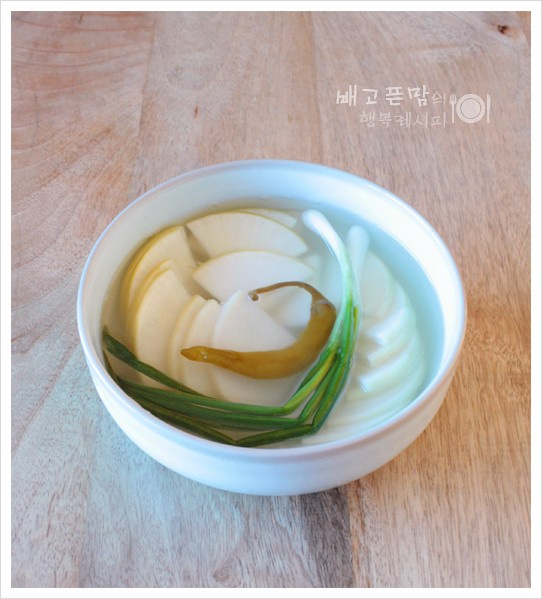Spicy and Refreshing Dongchimi: A Taste of Tradition
How to Make Dongchimi: The Secret to a Zesty Broth with Authentic Old-Fashioned Flavor

Every year, before making kimchi for winter, I make Dongchimi using radishes harvested from my garden. The green radish greens are dried for later use, the radishes are made into Dongchimi, and any remaining radishes are wrapped individually in newspaper and stored in an earthenware pot to be used as a vegetable until late spring. Although the radish in this Dongchimi is not yet fully ripe, it has a wonderfully zesty and flavorful broth. This 2021 Dongchimi captures the authentic taste of the past.
Dongchimi Ingredients- 16 Korean radishes (medium size)
- 1 cup coarse sea salt (approx. 200g)
- 4L purified water
- 1 pear (a sweet variety)
- 30 cloves garlic
- 4 slices ginger (garlic clove size)
- 3 handfuls fermented chili peppers (or fresh Cheongyang peppers)
- 2 handfuls green onions
Cooking Instructions
Step 1
Wash the radishes for Dongchimi thoroughly by rubbing them with a brush, without peeling. If there’s any stubborn dirt in the crevices of the skin, carefully scrape it off with a knife. Leaving the skin on will result in a clearer and more refreshing broth.

Step 2
In a large bowl, place 1 cup of coarse sea salt. With the radishes still slightly moist from washing, roll them in the salt, ensuring a generous coating of salt on the entire surface.

Step 3
The radishes harvested from the garden vary in size. It’s best to use medium-sized radishes for Dongchimi. I’ve prepared 16, but there’s quite a difference in their sizes.

Step 4
Arrange the salted radishes snugly in a kimchi container. Do not add any water at this stage. Close the lid and let them brine in a cool place for exactly 3 days. The key is to cure them using only the radish’s natural moisture and salt.

Step 5
After 3 days, tilt the kimchi container and you’ll see a significant amount of liquid has been drawn out from the radishes. We will use this brine as is. While keeping this aside, prepare the ingredients for the Dongchimi broth.

Step 6
I bought fermented chili peppers from a local market. Rinse them under running water, then drain them thoroughly on a sieve to remove excess moisture. Fermented peppers add a savory depth and a mild spiciness to the broth.

Step 7
A handful is about the amount you can hold in one hand. I’ve prepared 3 handfuls of fermented chili peppers. (You can adjust the quantity or use fresh Cheongyang peppers if you prefer more heat.)

Step 8
Prepare 30 cloves of garlic and 4 slices of ginger about the size of a garlic clove. Slice the garlic thinly into rounds and the ginger into very thin slices. Thin slicing is important for extracting their flavors effectively.

Step 9
Place the thinly sliced garlic and ginger into a piece of cheesecloth and tie the opening securely with string. This method allows the flavors to infuse without making the broth cloudy.

Step 10
Take one large pear, wash it thoroughly with the skin on, remove the core, and slice it as thinly as possible. The pear adds a natural sweetness and crispness to the Dongchimi broth.

Step 11
Wash and trim the green onions, and cut them into pieces about 3-4 cm long. Two handfuls are sufficient. Green onions add a fresh aroma and a vibrant green color to the Dongchimi.

Step 12
In the kimchi container where the radishes have been brining for 3 days, place the prepared garlic, ginger, fermented chili peppers, and thinly sliced pear in the center, amongst the radishes.

Step 13
Now, pour 4 liters of purified water into the kimchi container. This will combine with the radish brine to create the delicious Dongchimi broth.

Step 14
After adding the secondary ingredients to the center, gently press down the brined radishes, packing them snugly so they are mostly submerged in the liquid. Packing them tightly helps prevent air pockets.

Step 15
Finally, arrange the prepared green onions on top of the radishes. Close the lid of the kimchi container and let it ferment at cool room temperature for 4 days, then transfer it to a kimchi refrigerator to continue fermenting and chilling.

Step 16
After the initial 4-day fermentation at room temperature, I opened the Dongchimi container, which had been chilling in the kimchi refrigerator for another week.

Step 17
The characteristic savory aroma of well-fermented Dongchimi fills the air. The broth is already wonderfully zesty and refreshing! Take out a piece of Dongchimi radish, cut it into four long pieces, slice them thinly, and place them in a bowl. Ladle generous amounts of the Dongchimi broth over them. If you add boiled buckwheat noodles, crushed toasted sesame seeds, seaweed cut with scissors, and a touch of mustard paste to this zesty broth, you’ll have a delicious Makguksu (buckwheat noodle dish). Enjoy it with the refreshing Dongchimi broth!



